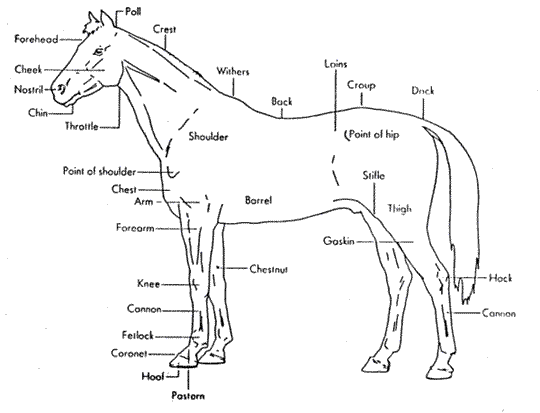| |
Grease
is a kind of eczema and a generic term for various sorts of
inflammation affecting the area from the hollow of heel to
the pastern area. It can even spread up to the cannons. The
first noticeable symptom is inflammation and small sores.
Subsequently the skin becomes rather swollen and tender. The
affected area weeps and the fluid dries, forming a scab. It
can be difficult to identify the symptoms as the disease is
very common in horses that have feather, such as the cold-blooded
breeds and ponies. Cracks can also occur, which exacerbates
the process. After a time the skin thickens and during the
healing process, transverse callouses form. The horse is irritated
by the itching. In severe cases there is a putrid, sweet smell.
The most common causes of grease are badly cleaned stabling,
very damp or muddy flooring and cold surfaces generally. Grease
can also develop from an inherited weakness of the skin over
the pasterns. Horses with white legs are more susceptible
than others. In more unusual cases, hypersensitivity of the
skin can be caused by contact allergy to, e.g., certain salves,
bedding, or some agent in the environment. Skin changes in
the pastern can allow various microorganisms to gain entry,
which is why secondary bacterial infections, fungal infections
or mites commonly develop from grease. If such infections
are allowed to gain a foothold, a prominent swelling can occur
on the lower part of the leg due to inflamed leg lymphatics
– lymphangitis.
If grease is detected early, the symptoms can be treated fairly
simply. However, the disease can become chronic, requiring
treatment periodically for the rest of the horse´s life.

Watchfulness
and carefulness are extremely important for detecting grease
symptoms at an early stage. As the Shire has feather, the
fingertips must serve as the ‘eyes’. Feel the
pasterns through the feather every day. They should feel soft
and silky at the skin surface. If not, apply a little greasy
ointment and massage well. The feather should not be cut away
as it helps to keep out the dirt. If grease is detected early
it may be sufficient to rub in an oily healing ointment two-three
times a day, or wash the area with diluted iodine solution
or even mild soapy water.
Ointments that contain cortisone can help. If you suspect
a bacterial infection you should contact your vet as a certain
type of antibiotic ointment might be needed. A disinfectant
compress is good if the skin is damp and festering, in which
case it might better to apply an ointment that dries the skin,
e.g. zinc salve. If it is a serious case then you might need
to cut away the feather to make it easier to clean the area,
but this is a last resort if you own a Shire!
If the situation is as above, then it is very important to
keep the legs clean. It may be advisable to wash them in the
evening. Brush off the worst of the mud as soon as the horse
is stabled, dry the legs, and brush and groom again when the
legs are completely dry. To make sure the legs are absolutely
clean, wash them and blow the feather dry with a hair dryer.
Horse owners know lots of cures for grease, so ask others
who have had the same problems and find out how they solved
them.
|
